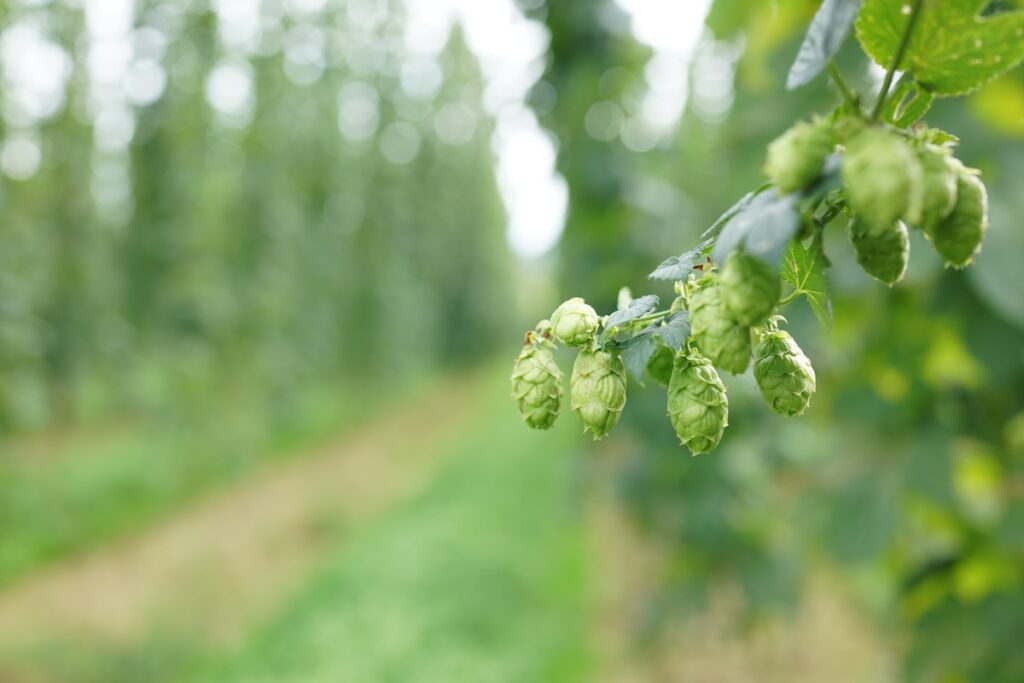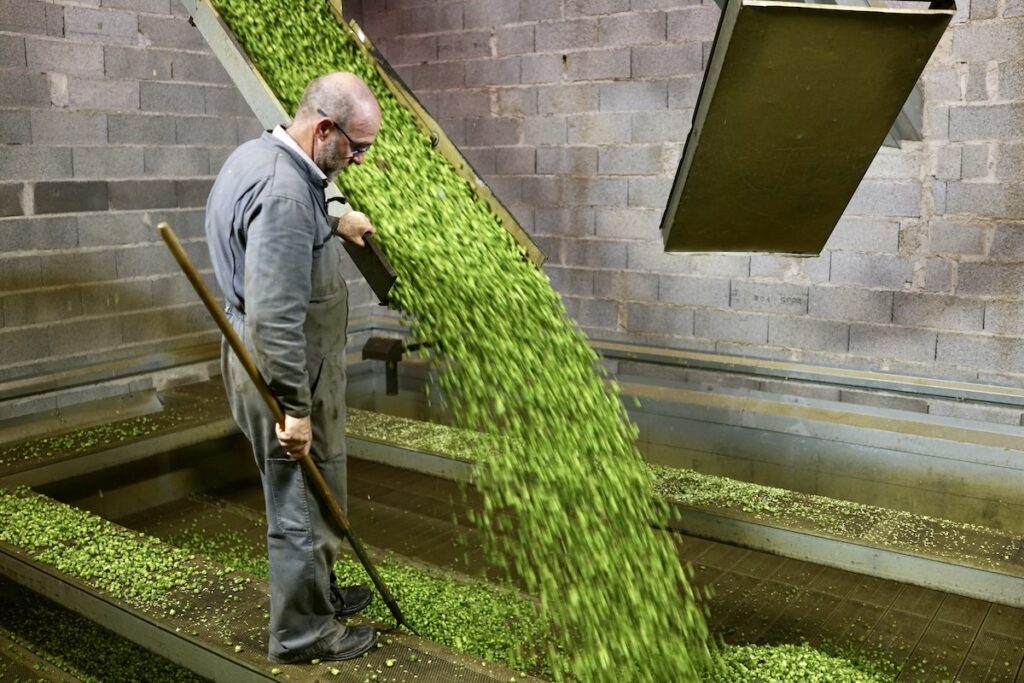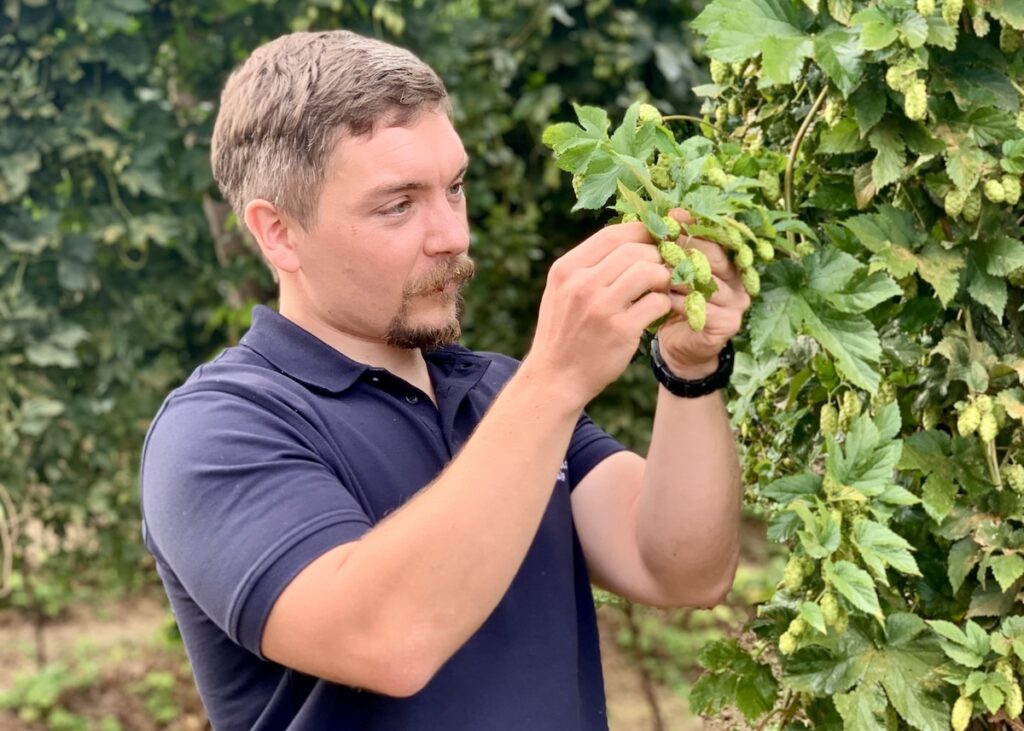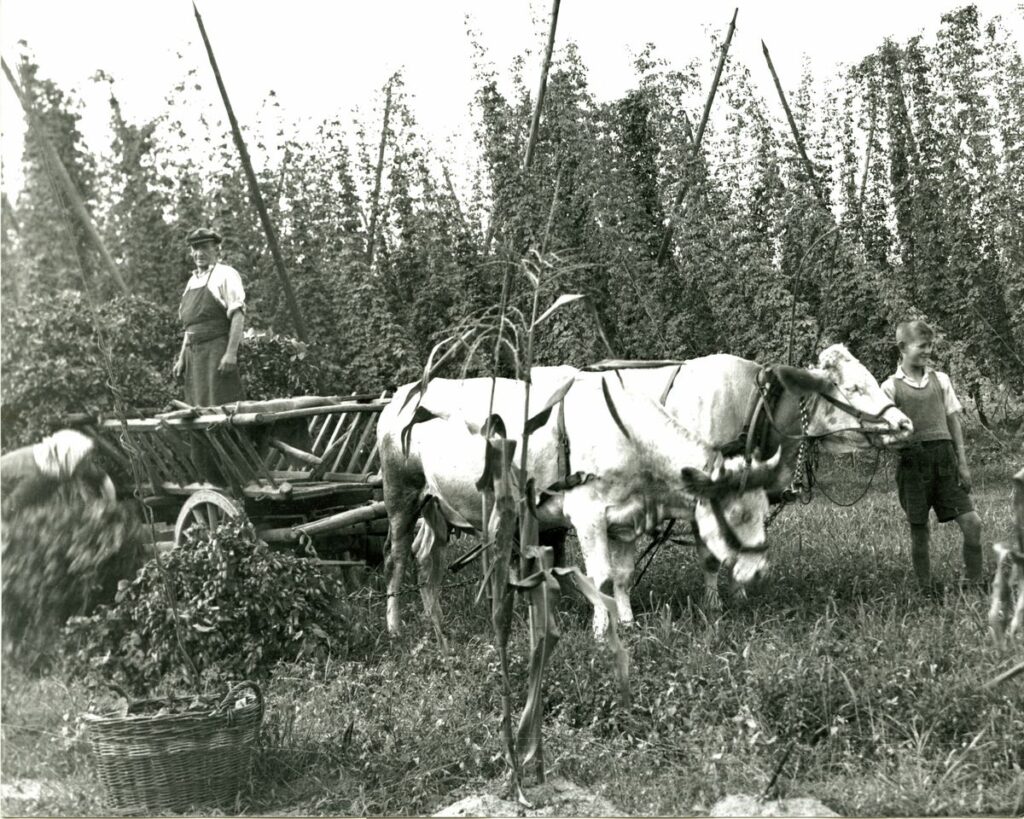(English follows the Japanese below)

フランスのホップの歴史について語るべく、フランスから数々のホップを輸入する株式会社BETのセバスチャン・ホヘンタナに話を伺った。
フランスにおけるホップ栽培の概要をご説明いただけますか?
フランス産の酒類について語るとき、多くの人はワインを連想すると思いますが、ドイツやベルギー、イングランド(海を挟みますが)などのビール王国に隣接する地域では、古くからビールがつくられています。フランスの北東部でドイツとの国境に位置するアルザス地方は、ホップの栽培に関しても長い歴史を持っていて、約99%のフランス産ホップはこの地域とその周辺で栽培されています。
アルザス地方でここまで栽培が盛んに行われている背景は何でしょうか?
後ほど話しますが、もちろん地理的な要因が大きく関わっていますし、この地方は昔からずっとフランスのビール文化の中心でした。クローネンブルグという醸造所は1664年にこの地方で創設されたといわれています。この地方ではワイン用のブドウが上手く育たない時期があり、ワインの供給が思わしくなかったため、人々は代わりにビールをつくり始めました。それに応えるように、ホップと醸造用麦芽の栽培も始まったのです。クローネンブルグは、ビールをつくるために設立された地元企業の一つで、最初の拠点となったカフェ&レストランは今でも見ることができます。今日、同社最大の生産施設はこのアルザス地方にあります。また、大きな醸造所だけでなく、中心都市であるストラスブールの郊外には、もっとも古い個人経営の醸造所ブラッスリーメテオールもあります。ここではホップの文化が根強いのです。
フランスの醸造所の状況について、もう少し教えてください。
現在フランスには、約2,500の醸造所があり、全体でおよそ350,000キロリットルのビールを生産しています。クラフトビールの醸造はここ数年で爆発的に増加し、ブルワーズ・オブ・ヨーロッパ・アソシエーション(欧州醸造者協会)によると、現在フランスはクラフトビール醸造所の数において欧州を牽引しています。その多くが店内に併設されたブルーパブであるため、多くの人はこれらを小規模な醸造所と考えるでしょう。しかし、フランスには大規模な醸造スペース(30〜100ヘクトリットルの規模)を持つ、第2、第3段階の拡張期にある、かなり発展した醸造所もたくさんあります。その成長は著しく、フランス産ポップの生産において優れた業績を挙げていると、フランス政府からも正式に認められました。マクロン大統領は、ホップ生産者の公式な協会であるホップ・フランス・コントワール・アグリコルの経営陣とも会っていました。この組織については後ほど話しますが、フランシス・ハイツ氏がホップに関するオペレーションを行なっています。彼はアルザスの農家の5代目または6代目で、ホップ農場で生まれ育ちました。現在は、彼の兄弟が農場を経営しています。彼らがマクロン大統領と会った際に、フランスの在来品種を贈り、それはフランス共和国大統領官邸である、エリゼ宮殿にある庭園に植えられました。フランスでのクラフトビールブームとそれを取り巻くあらゆるものが、若者に新たな職場を与えるということで世間から脚光を浴び、大統領にまで届いたのです。
協会についての話に移る前に、アルザス地方でのホップ栽培の歴史についてもう少しお話いただけますか?
ホップ生産者の多くが、アルザスの都市部であるストラスブール北部から来ています。家族経営の農場が40軒以上あり、500ヘクタールほどの栽培面積を持ち、全体で約800トン生産しています。ホップ栽培の歴史は産業革命以前まで遡りますが、その主な要因はクローネンブルグと、1640年に創業されたフランス最古のメテオール醸造所(現在も家族経営で営業中)です。1796年にホップ栽培が初めて確認されましたが、醸造の歴史によれば、アルザスではもっと前からホップが栽培されていたようです。この地で栽培されたオリジナル品種、ストリスルシュパルトの名前は1885年に言及され、現在ではそれが正式名称となっています。興味深いことに、この時代のほうがホップを多く使用していたため、今よりも栽培面積が大きかったのです。20世紀に入ると、醸造の効率が上がったことや、大企業のビール(大量生産のラガー)がスタンダードになったこともあって、ホップの生産量は減少しました。ただ、クラフトビールブームのおかげで栽培面積は後に増加します。ひとつ興味深いのは、ホップのツタはロープに沿ってまっすぐ育たないんです。使用するトレリス(ツル性の植物を絡ませる格子状の垣)は7メートルほどの高さなのに対して、ロープは9メートルあり、若干余裕を持たせています。葉を刈り取る底の部分が2メートル余分にあるため、世界のほかの栽培地域よりも除草剤や農薬の使用量を減らしてホップを栽培することができます。おかげで、フランスはEU諸国の中でもオーガニックのホップ栽培に関しては先進国となっています。また、アルザス地方で採用されているホップの栽培方法は、ドイツの技術に基づいています。この地方は過去数世紀にわたって、フランスとドイツの間で政権交代がおこなわれ、多くの人々が今もドイツ語を話しますし、アルザス地方のビールと食文化は、ドイツのものによく似ています。ドイツとフランスの両方の伝統がこの地域に影響を与えたのです。

このホップ栽培産業の形式化が進んだのはいつですか?
1939年に設立された栽培者の組合があったのですが、1960年に彼らは海外の品種を育て始めました。最終的に彼らは、日本のJAのようなコントワール・アグリコルという組織を創りました。そして独自の品種を販売するために「ホップ・フランス」の品質商標を使い始めました。2000年には独自の育種計画も開始し、現在、フランス特有の品種が7種類あり、国際品種も少し栽培しています。フランスの品種である7つには、この地の伝統的な品種である(言い換えれば、温室で開発されたものではない)ストリスルシュパルト、アラミス、トリスケル、バーブ・ルージュ、ミストラル、エリクサー、そして今年リリースされたテオレムがあります。
育種計画の仕組みについて、説明をお願いします。
フランスのホップの場合は、ストリスルシュパルトをカスケードなどほかのホップと交配させました。温室で栽培を開始し、もしそこでの生育状況が良ければ、それを研究用の畑に移します。病気に対する抵抗力、生育条件、収量やその他の項目をチェックするのです。この計画の当初の目的は、ストリスルシュパルトに似た香りを持ち、苦味を出すためのα酸(アルファ酸)をより多く含んだ品種を育てることでした。ストリスルシュパルトには平均1.5%から2.5%ほどしかα酸が含まれておらず、極めて低い数値で、状態の悪い収穫期には0.8%から1.2%に下がってしまうこともあります。もしもレシピ上の数値が2%となっているのにも関わらず、翌年にはα酸含有量が1%になったとしたら、使用するホップの量を倍にしなくてはなりません。全ての醸造システムがそのために設計されているわけではありません。大規模な醸造所では、工程は自動化されているため、機械が小さすぎて余分なホップの量に対応ができないという問題が生じていました。育種家たちは目的を達成し、さらに、その過程でほかの興味深い品種も発見しました。
地理も重要な要素だと思いますが、ここまで大きな割合のフランス産ホップがここで育っていることには、どのように関係しているのでしょうか。
この地域はシュヴァルツヴァルトという山地とヴォージュ山脈の間に位置しているため、栽培に使用される土地は十分に保護され、ライン川のおかげで安定した水の供給があります。考えてみればヤキマ(米国ワシントン州のホップの産地)も谷にあり、似たような強みを持っています。気候も安定していて、暑くなりすぎることもありません。近年、地球全体で温暖化が進んでいますが、この地域はそこまで大きな影響を受けていないのです。もっと暑い気候で、水も限られている場合に、ホップのα酸数値は高くなる傾向にあります
つまり、アルザスのテロワール(その産地特有の自然環境)が関係しているということですね。
アルザスには間違いなく、ほかとは異なるテロワールがあります。この地域は白ワインで有名で、ワインに良い条件が揃っているということは、ホップ栽培にも良いといえます。ニュージーランドやオーストラリアのホップが育つ場所を見てみると、それらはワインでも有名な地域です。どちらの作物にも、気候と土壌が適しているということになります。ここアルザスにはブドウ園は山側、ホップ畑が平地に広がり、農業の入り混じる美しい光景があります。テロワールのおかげでフランスのホップははっきりとした味わいがありますが、太平洋岸北西部のホップほどの鋭さはありません。例えばヤキマで育つカスケードにはしっかりとしたシトラス、松、干しぶどうのような香りがありますが、フランスのものはオレンジのようなシトラスの香りがあり、よりまろやかで、α酸は1~2%ほど低くなり、ダンクな(草のような)特徴が薄まります。このような性質を好んで、フランス産のカスケードを使用している日本の醸造所もあります。実際のところ、フランス産ホップの風味はどこをとっても極端な特徴を持っていることは稀です。
反対にフランスのホップを使用するのに向いていないビールのスタイルはありますか?
ホップ感が強く、かなりフルーティーなヘイジーIPAをつくりたい場合には、もちろんフランス産の品種でも可能ですが、簡単ではないのでレシピを試行錯誤する必要があります。逆にピルスナーやペールエールなど、ホップの特徴をそれほど主張しないものをつくりたいのであれば、これ以上のものはないと思います。
フランス産ホップを使用している醸造所を教えてもらえますか?
全てを教えることはできませんが、日本でもお馴染みの一般に知られているブランドとしては、オルヴァル、シエラネバダ、ロシアンリバー、ウェストマール、サン・フーヤン、ロシュフォールなどがあります。ベルギーのサワービールの多くにもフランスのホップが使用されていますが、特徴的なのが、醸造所でホップを熟成させることです。10~20度で2、3年保管することでホップを酸化させてから、ランビックやサワービールに使用します。また、私たちは樽熟成ビールやサワービールに使用したい日本の醸造所にも、「古い」ストリスルシュパルトを販売しています。
セバスチャン、ありがとうございました。これらフランス産のホップを使用したビールを探して、ぜひ試してみようと思います。
アルザスのテロワール(その産地特有の自然環境)では、6種類のフレンチホップが産出されており、それぞれがユニークな特徴を持っている。
Strisselspalt
ザーツのDNAを持つ伝統的品種「ストリスルシュパルト」は、伝統的なノーブルホップのアロマと相まって、円熟した心地よい苦味で知られている。アルザス・ピルスナーを醸造するならこのホップが第一候補だ。
Aramis
「アラミス」は、ストリスルシュパルトの兄貴分として、ビールの苦味の質の高さはそのままに、シトラス、新鮮なハーブ、スパイスの香りをほのかに加えているのが特徴である。爽やかなラガーに最適。
Triskel
「トリスケル」は、ストーンフルーツ(核果)やブドウにジャスミンやハニーサックルを組み合わせたような、フルーティーで華やかなアロマホップである。ホップが利いた辛口のペールラガー、ブロンドエール、セゾンに最適なアクセントとなる。
Barbe Rouge
「バーブ・ルージュ」は、レッドベリーのユニークな香りを持つ、フランスが誇る品種である。甘味のあるビールではイチゴの風味、酸味のあるビールではラズベリーの風味を際立たせることができる。
Mistral
「ミストラル」は、ライチやキンカンのトロピカルなアロマに、花束のような華やかさを組み合わせた強烈な香りが特徴である。セッションIPAやドライホップラガーに最適なホップ。
Elixir
「エリクサー」は、パッションフルーツのトロピカルなアロマに、甘い柑橘類やタンジェリンの特徴を持つ、豊かな果実の味わいが特徴である。ドライホッピングに最適で、あらゆるタイプのIPAに甘い果実の心地よいアロマを加えることができる。
Teorem
「テオレム」は、2023年にフレンチホップのラインナップに追加されたばかりの最新品種だ。マンゴーやパパイヤを連想させるエキゾチックなフルーツと、新鮮なシトラスとほのかに松ヤニのような香りがするのが特徴。現代的なIPAに使うホップとして大きな可能性を感じさせる品種である。

For this article, we sat down for a discussion on the history of French hops with Sebastian Hohentanner of BET, which imports a variety of hops from France.
Please give us a general overview of hop cultivation in France.
When discussing alcoholic beverages in France, most people talk about wine country, but there’s a long history of beer production, too, especially in the regions that border beer countries like Germany, Belgium, and (across the channel) England. In the northeastern part of France, in the Alsace region bordering Germany, there’s also a long history of hop cultivation. Close to 99% of French hops are grown in or near Alsace.
What is it about Alsace that created this level of activity?
It’s always been the heart of French beer culture, for starters, while the geography, which I’ll touch on later, is important, too. The brewery Kronenbourg claims it was founded here in 1664. The region went through a brief period where it was difficult to grow wine grapes and the wine supply was so bad that people started making beer. Kronenbourg was one of the local businesses that emerged to make beer. You can still see the cafe restaurant, in fact, where it got its start. Locals, in response, started growing hops and brewing barley in the region, and today the brewery’s largest production facility is in this Alsace region. It’s not only big breweries that you’ll find here; the oldest privately owned brewery, Brasserie Meteor, is located nearby, just outside Strasbourg. Hop culture is strong here.
Please tell me a little more about the brewery scene in France.
At present there are about 2500 breweries (over 90% are microbreweries) that produce a total of 350,000kl. Craft brewing has exploded over the past few years. Surprisingly, France is currently leading Europe in the number of craft breweries per the Brewers of Europe Association. Most would consider these microbreweries, of course, because many are on-premise brewpubs. But there are a lot of well-developed French breweries in their second or third stage of expansion with large brewhouses (in the 30 to 100 hectoliter range). There’s significant growth, leading in part to French hop growing having earned official recognition from the government of France. President Macron has even met with the operators of Hop France Comptoir Agricole, the official growers organization which we’ll talk about later. Francis Heitz is the person who runs the hops operation. He grew up on a hop farm and his brother still runs it; he is a fifth or sixth generation Alsatian farmer. When they met Macron, they gave him a French heritage variety which was planted in the garden of the Élysée Palace, the official residence of the French president. The craft beer boom in France, and everything surrounding it, has gotten such visibility, up to the president, because it presents new opportunities for work, especially for young people.

Before we turn to that organization, please tell me more about the history of hop cultivation here.
Most hop workers come from the region north of Strasbourg, the major city in Alsace. There are over forty family farms and about five-hundred hectares planted, totaling some eight-hundred tons in volume. The history of hop growing dates back to pre-industrial times here, again, due in large part to Kronenbourg, as well as Meteor Brewery, France’s oldest dating back to 1640 (still operating and family owned). 1796 marks the first confirmable date of hop cultivation, though brewing history suggests that hops have been grown in Alsace from a much earlier date. The name of the original land-grown variety, Strisselspalt, was mentioned in 1885, and that’s now its official name. Interestingly, there was much more acreage in those times because more hops were used. In the 20th century, hop production declined, in part because of increased brewery efficiency, and because of ‘big beers’ (industrial lagers) becoming the standard. Acreage later grew because of the craft beer boom. One interesting detail is that the hop bines don’t grow straight up the ropes. The trellises are about seven meters tall but the ropes are nine meters, allowing some slack. Those two extra meters at the bottom where the leaves are cut allow for growing hops with less herbicides and pesticides than in most other growing regions in the world. Based on that, France has become the leading country for organically grown hops in the EU.
As for actual cultivation methods, Alsatian hop farming is based on German technology. Over the last few centuries, the region passed back and forth between French and German political administrations, and many people there still speak German. The whole beer scene in Alsace, as well as food culture, is very similar to Germany’s. Both German and French traditions influenced the area.
When did the hop growing industry become more formalized?
There was a growers association formed in 1939. In 1960, they started growing other international varieties. Eventually, local hop growers in Alsace integrated their endeavors into Comptoir Agricole, the sort of French equivalent of JA in Japan, and they launched the Hop France quality seal to market their own varieties. It was in 2000 that they started their own breeding program. There are now seven unique French varieties, and they also grow a handful of international varieties. The seven French ones include: Strisselspalt, the original land-grown variety (in other words, not developed in a greenhouse), Aramis, Triskel, Barbe Rouge, Mistral, Elixir, and Teorem, which was just released this year.
Please explain how the breeding program works.
In the case of French hops, they crossed Strisselspalt with other hops, like Cascade for example. They start in the greenhouse, and if they grow efficiently here, they move them to the research fields. They check for resistance to disease, growing conditions, yield, and other factors. The original goal of the program was to grow hops that were similar to Strisselspalt in aroma but had more alpha acids for bittering. Strisselspalt averages between only 1.5 and 2.5%, which is super low. In a bad harvest year, that might be 0.8 to 1.2%. If you have a recipe with 2% but then the next year you get alpha acid content of only 1%, you have to double the amount of hops you use. Not all brewing systems are built for that. At bigger breweries, the process is automated; that created problems since machinery was too small to accommodate the extra hop volume. The breeders succeeded in their goal, but along the way they discovered other varieties that were interesting, too.
I imagine geography is an important variable, too. How has that contributed to such a large percentage of French hops being grown here?
The region is located between the Black Forest Mountains and the Vosges Mountains. So the actual land used for cultivation is well-protected and has a stable water supply because of the Rhine River. If you think about it, Yakima is in a valley, too. There are similar advantages. The climate is stable; it doesn’t get crazy hot. Although the world has gotten hotter in recent years, this region hasn’t been so badly affected. When you have a hotter climate and water restrictions, hops tend to have higher alpha acids.
So there’s a kind of terroir at work here, correct?
Alsace definitely has a distinct terroir. The region is famous for white wines. And where conditions are great for such wines, they are generally great for hops. If you look at where hops are grown in New Zealand and Australia, they are also wine regions. The climate and soil are favorable for both plants. Here in Alsace, you’ll see grape vineyards on the mountainsides and hopfields in the flats. It’s a scenic blend of agriculture. As a result of the terroir, French hops have flavors that are well expressed, but perhaps not as pungent as hops from the Pacific Northwest, for example. Cascade grown in Yakima, for example, will have assertive notes of citrus, pine, and resin, but in France it’s rounder–more citrusy and orange-like, and the alpha acids might be a percentage point or two lower. Dank character is diminished. There are brewers in Japan that really like the French Cascade because of those qualities. In fact, the flavor descriptors of French hops are rarely extreme in any direction.
By contrast, then, are there some styles of beer for which they might not be suitable?
If you wanted to brew a hazy IPA that’s super hop-forward and super fruity, it’s possible with French varieties, but isn’t that easy and will require some serious recipe tinkering. Some just don’t give you the punch you want. But if you’re making pilsners, pale ales, or anything with hop character that isn’t that assertive, you won’t find much better.
What are some breweries that use the hops?
I’m not permitted to name all of them, but some publicly known brands that might be recognized in Japan include Orval, Sierra Nevada, Russian River, Westmalle, St. Feuillien, Trappistes Rochefort, and several others. There are a lot of Belgian sour beers made with French hops, but what is unique is that the breweries will age the hops. They’ll store them at between 10~20C for two or three years so that the hops oxidize. Then the brewers will use them in lambics and other sour beers. We also sell ‘older’ Strisselspalt to breweries in Japan that want to use it in barrel-aged beers or sour beers.
Thank you, Sebastian. We’ll be on the lookout for beers using these hops to give them a try.
The Alsatian terroir produces seven exclusive French hop varieties each with its unique characteristics.
Strisselspalt, the heirloom variety with Saazer DNA, is famous for its round and pleasant bitterness in combination with a classic noble hop aroma. The first choice for any properly brewed Alsatian Pilsner.
Aramis, the big brother of Strisselspalt, features the same high quality of bitterness in beers but adds a subtle note of citrus, fresh herbs and spice. A perfect choice for refreshing lager beers.
Triskel is a fruity and floral aroma hop reminiscent of stone fruit and grapes in combination with jasmine and honeysuckle. A perfect accent in dry hoppy pale lagers, blond ales or saison beers.
Barbe Rouge is the pride of the French breeding program showcasing a unique aroma of red berries. Best highlighted as a distinctive strawberry flavor in sweeter beers or a raspberry flavor in sour beers.
Mistral has the intense fragrance of a rich flower bouquet combined with lychee and kumquat tropical aromas. A great hop in session IPAs and dry hopped lagers.
Elixir is fruit forward with a sweet citrusy, tangerine character backed up by tropical aromas of passion fruit. A great dry hopping choice that adds a pleasant aroma of sweet fruit to all types of IPA.
Teorem is the latest addition to the French hop line up just released in 2023. Exotic fruits, reminiscent of mango and papaya combined with a fresh citrus impression and a resinous character in the back define the aroma. A variety with great potential for modern IPAs.
This article was published in Japan Beer Times # () and is among the limited content available online. Order your copy through our online shop or download the digital version from the iTunes store to access the full contents of this issue.


